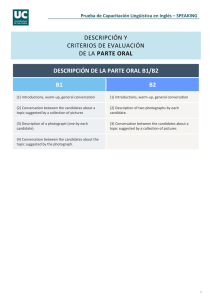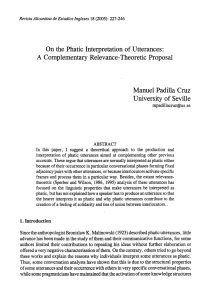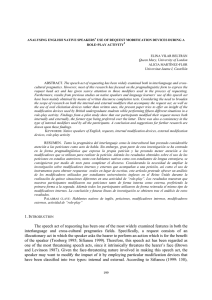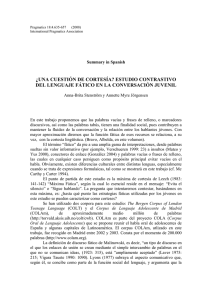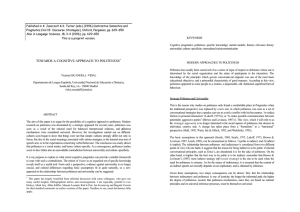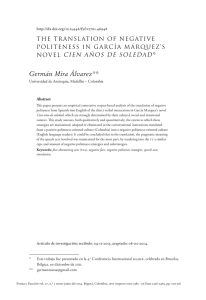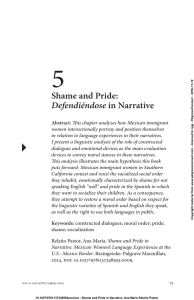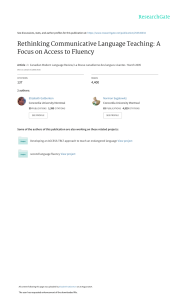politeness of some linguistic expressions are one of the major
Anuncio
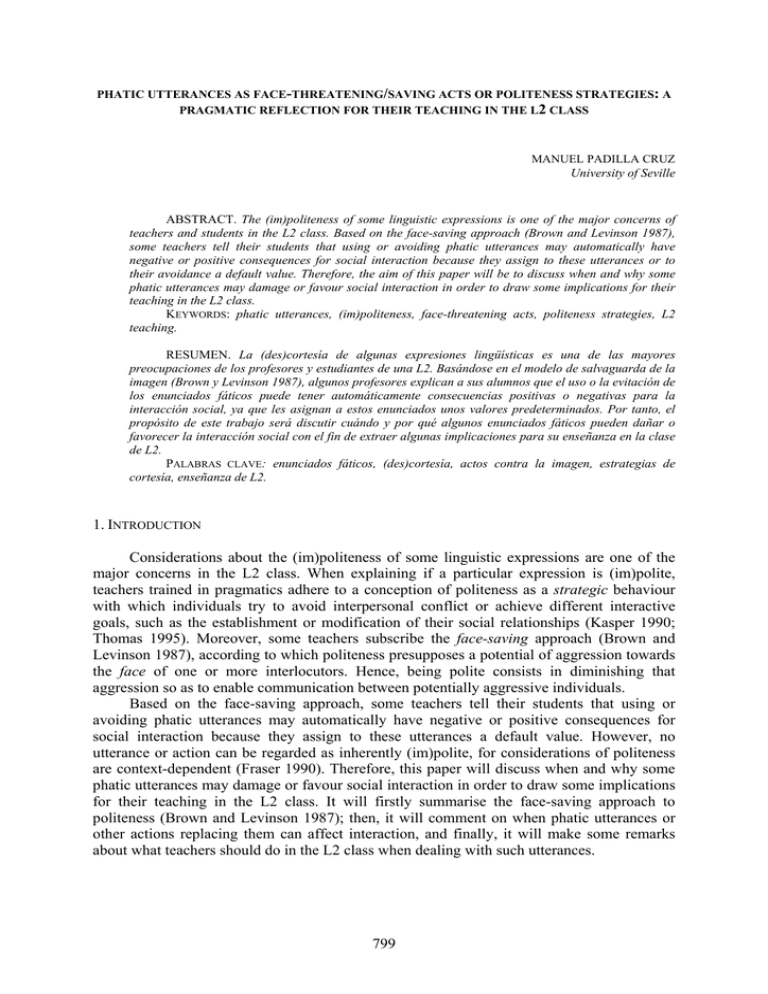
PHATIC UTTERANCES AS FACE-THREATENING/SAVING ACTS OR POLITENESS STRATEGIES: A PRAGMATIC REFLECTION FOR THEIR TEACHING IN THE L2 CLASS MANUEL PADILLA CRUZ University of Seville ABSTRACT. The (im)politeness of some linguistic expressions is one of the major concerns of teachers and students in the L2 class. Based on the face-saving approach (Brown and Levinson 1987), some teachers tell their students that using or avoiding phatic utterances may automatically have negative or positive consequences for social interaction because they assign to these utterances or to their avoidance a default value. Therefore, the aim of this paper will be to discuss when and why some phatic utterances may damage or favour social interaction in order to draw some implications for their teaching in the L2 class. KEYWORDS: phatic utterances, (im)politeness, face-threatening acts, politeness strategies, L2 teaching. RESUMEN. La (des)cortesía de algunas expresiones lingüísticas es una de las mayores preocupaciones de los profesores y estudiantes de una L2. Basándose en el modelo de salvaguarda de la imagen (Brown y Levinson 1987), algunos profesores explican a sus alumnos que el uso o la evitación de los enunciados fáticos puede tener automáticamente consecuencias positivas o negativas para la interacción social, ya que les asignan a estos enunciados unos valores predeterminados. Por tanto, el propósito de este trabajo será discutir cuándo y por qué algunos enunciados fáticos pueden dañar o favorecer la interacción social con el fin de extraer algunas implicaciones para su enseñanza en la clase de L2. PALABRAS CLAVE: enunciados fáticos, (des)cortesía, actos contra la imagen, estrategias de cortesía, enseñanza de L2. 1. INTRODUCTION Considerations about the (im)politeness of some linguistic expressions are one of the major concerns in the L2 class. When explaining if a particular expression is (im)polite, teachers trained in pragmatics adhere to a conception of politeness as a strategic behaviour with which individuals try to avoid interpersonal conflict or achieve different interactive goals, such as the establishment or modification of their social relationships (Kasper 1990; Thomas 1995). Moreover, some teachers subscribe the face-saving approach (Brown and Levinson 1987), according to which politeness presupposes a potential of aggression towards the face of one or more interlocutors. Hence, being polite consists in diminishing that aggression so as to enable communication between potentially aggressive individuals. Based on the face-saving approach, some teachers tell their students that using or avoiding phatic utterances may automatically have negative or positive consequences for social interaction because they assign to these utterances a default value. However, no utterance or action can be regarded as inherently (im)polite, for considerations of politeness are context-dependent (Fraser 1990). Therefore, this paper will discuss when and why some phatic utterances may damage or favour social interaction in order to draw some implications for their teaching in the L2 class. It will firstly summarise the face-saving approach to politeness (Brown and Levinson 1987); then, it will comment on when phatic utterances or other actions replacing them can affect interaction, and finally, it will make some remarks about what teachers should do in the L2 class when dealing with such utterances. 799 2. BASIC POSTULATES OF THE FACE-SAVING APPROACH The face-saving approach to politeness (Brown and Levinson 1987) rests on two assumptions. Firstly, the assumption that individuals follow the Cooperative Principle (Grice 1975) and that in those cases when they seem not to cooperate the reason that explains such behaviour is their intention to be polite. Secondly, the assumption that individuals are characterised by two features: rationality and face, which is “[…] the public self-image that every member [of a society] wants to claim for himself” (Brown and Levinson 1987: 61). Face has two opposed but complementary components: (i) Negative face, “[…] the want of every ‘competent member’ [of a society] that his actions be unimpeded by other” (Brown and Levinson 1987: 62). (ii) Positive face, “[…] the want of every member [of a society] that his wants be desirable to at least some others” (Brown and Levinson 1987: 62). Face is a vulnerable personal attribute that can be maintained, enhanced or lost during social interaction, so interlocutors are normally interested in protecting their own face and the face of others from aggressions. Those aggressions come from (non-)verbal actions, which Brown and Levinson (1987) call face-threatening acts (FTAs). In turn, these can affect the speaker’s or the hearer’s positive or negative face. However, protecting one’s own face and the face of others may be a hard task, since the speaker must simultaneously communicate her message in the most efficient way and maintain her own face and that of the hearer. For this reason, interlocutors can use a series of linguistic strategies (Brown and Levinson 1987: 68-69): 1. Performing the FTA baldly on-record, without redressive action. 2. Performing the FTA on-record, with redressive action by means of positive-politeness strategies. Positive politeness is aimed at maintaining the interlocutors’ positive face, so it relies on the expression of solidarity, reciprocity, in-group membership, the sharing of feelings, emotions, intentions, attitudes or points of view. 3. Performing the FTA on-record, with redressive action by means of negativepoliteness strategies. Negative politeness is aimed at maintaining the individuals’ negative face, so it is based on the expression of the unwillingness to impede their freedom of action and minimising the imposition of some acts. 4. Performing the FTA off-record. 5. Avoiding the FTA. Speakers decide whether or not to perform an FTA and which politeness strategy to use on the basis of its weightiness. This is determined by the values of three sociological variables: the social distance (D) between the hearer and the speaker, their relative power (P) and the rank of imposition (I) of the act in a given culture or sociocultural group. Many teachers use this approach to account for the (im)politeness of linguistic expressions such as phatic utterances. The next section discusses if these utterances or others replacing them really constitute FTAs or politeness strategies intended to mitigate face threats. 3. PHATIC UTTERANCES AS FTAS OR POLITENESS STRATEGIES Starting a conversation with phatic utterances or resorting to them to keep a conversation may not entail any risk for social interaction in many cases because such utterances do not constitute any threat to the hearer’s negative face. However, in other cases those actions may threaten the hearer’s negative face, as they could probably bother him, above all if the he and speaker do not know each other, or if their status or age are different 800 (Tannen 1985: 98). Therefore, teachers sometimes tell students that phatic utterances are FTAs against the hearer’s negative face and that the safest option in this case is to avoid them and remain silent owing to the potential weightiness that uttering them would have. In spite of this, a particular linguistic expression or action, or its avoidance, cannot be said to be inherently (im)polite (Fraser 1990). They should know that silence is ambiguous and can be interpreted, for example, as a sign of a bad mood or shyness (Jaworski 1993: 85; Sifianou 1995: 100-101, 1997: 71; Sobkowiak 1997: 54), and hence affect the speaker’s positive face. Silence would certainly be the safest option if the other individual does not speak, as it could avoid a possible interpersonal conflict (Tannen 1990: 260; Jaworski 1993: 25; Sifianou 1995: 101). By means of silence the speaker could show her consideration for or deference towards the hearer, above all if he is older or more powerful than her (Tannen 1985: 98; Kurzon 1992; Watts 1997). Likewise, silence would be polite in those cases when the speaker feels that what she intends to say could generate disagreement or be understood as a sign of disapproval (Sifianou 1995: 102), for it would also avoid an interpersonal conflict. Obviously, the (in)convenience of being silent or using phatic utterances would also depend on the interactive maxims or principles individuals have internalised. For example, Leech (1983) believes that the usage of phatic utterances is due to the operation of the phatic maxim, which prompts interlocutors to keep on talking. Similarly, Schneider (1988) postulates the existence of maxims such as “avoid conflict” and “avoid curiosity”, which govern the usage or avoidance of such utterances. The interlocutors’ abidance by these maxims may justify their linguistic behaviour and render it (im)polite in specific circumstances. On the other hand, the lack of a phatic token when two individuals meet or during a conversation may also involve a threat to the hearer’s positive face. Phatic utterances create solidarity, agreement and ties of union between interlocutors (Lyons 1968; Leech 1983; Coupland, Coupland and Robinson 1992) and they achieve these effects because they are face-satisfying acts and manifestations of the first eight positive-politeness strategies proposed by Brown and Levinson (1987) in their model (Holmes 1988; Schneider 1988; Herbert 1990; Chen 1993). More exactly, in some circumstances phatic utterances may be regarded as instantiations of the seventh of such strategies, which leads interlocutors to presuppose common ground and state the existence of affinity with hearers. With positive politeness the speaker treats the hearer as a person whose personal desires, likes, intentions, preferences and features she knows and admires. This is so because positive-politeness strategies rely on the expression of approval and interest in the hearer, the usage of markers of in-group membership, the search for agreement, or the establishment of reciprocity as regards the interlocutors’ desires, likes, intentions, preferences or features (Brown and Levinson 1987; Brown 2000). Nevertheless, this perspective may also pose some problems for teachers and students. Firstly, phatic utterances cannot either be considered face-satisfying acts in a decontextualised manner. In fact, acts such as compliments, which may receive a phatic interpretation (Wolfson and Manes 1980; Boyle 2000), can threaten the hearer’s negative face if, for instance, there is not much intimacy between the interlocutors (LewandowskaTomaszczyk 1989: 75; Sifianou 1997: 70). Similarly, some compliments intended as merely phatic remarks by the speaker may condition the hearer’s subsequent behaviour, as the hearer may understand them as expressions of desire, and that may threaten the hearer’s negative face (Herbert 1989; Chen 1993; Jaworski 1995). Secondly, the fact that interlocutors use phatic utterances to establish ties of union or solidarity also depends on the interactive maxims or principles they obey. Thus, if a cultural 801 group favours the maxim of approbation – “minimise dispraise to other” (Leech 1983) – its members are likely to use such utterances for that purpose. On the contrary, if they follow the maxim of modesty – “minimise praise of self” (Leech 1983) – they may tend to avoid them. Similarly, the use of phatic utterances with this aim may be justified if interlocutors abide by maxims such as “say something nice”, “show interest” or “create ties of union” (Schneider 1988). Finally, teachers should not always present phatic utterances as positive-politeness strategies. In his work on phatic communion in the UK and USA, Laver (1974) differentiated between neutral phatic utterances, which refer to the setting of the conversation (1), and personal phatic utterances, which allude to the participants (2): (1) The bus seems to be delayed. (2) New hairdo! He also observed that the usage of both types of phatic utterances in the UK and USA depends on the interlocutors’ social relationship. When interlocutors maintain a solidarity relationship – a solidarity politeness system (Scollon and Scollon 1995) – they can use both types of phatic utterances. If interlocutors are socially distant and there is no power difference between them, i.e. if they interact in a deference politeness system (Scollon and Scollon 1995), they tend to select neutral phatic utterances and avoid personal ones. Finally, if there is a power difference between them regardless of whether they are socially distant or close, i.e. if they interact in a hierarchical politeness system (Scollon and Scollon 1995), the more powerful speaker may use personal phatic utterances about the less powerful one but not about herself, and the less powerful speaker may use personal phatic utterances about herself, but not about the more powerful individual. Although these seem general tendencies, the occasional usage of personal phatic utterances in a deference politeness system is understood as an attempt by the speaker to establish solidarity with the hearer, so in this case this type of phatic utterances would be a positive-politeness strategy because it favours intimacy, proximity or affinity. On the contrary, the usage of neutral ones can be identified with a negative-politeness strategy, as such utterances result in social distancing, independence, freedom of action or imposition. Likewise, the occasional usage of personal utterances about herself by the more powerful individual in a hierarchical politeness system would be a positive-politeness strategy aimed at the temporary offer of solidarity, whereas personal utterances about the hearer and neutral ones would be negative-politeness strategies aimed at reinforcing status differences. However, the usage by the less powerful speaker of personal phatic utterances about the more powerful speaker would constitute a FTA, as it may be understood as an invasion of the superior’s intimacy or as if forcing the establishment of temporal solidarity. 4. IMPLICATIONS FOR THE L2 CLASS The face-saving approach rests on the assumption that performing some acts or using some linguistic expressions may automatically have negative consequences for social interaction because they may involve some damage to the interlocutors’ faces or enhance social interaction because they satisfy their face needs. However, teachers should emphasise that no action or utterance is inherently, and in a decontextualised manner, (im)polite or can be considered as a face-threatening/enhancing act, for this depends on the context where it is produced and interpreted, as well as on the interlocutors’ social identity (Fraser 1990). Consequently, teachers should make students aware of the necessity of evaluating the contextual factors and sociological variables conditioning and intervening in social interaction before deciding about the (in)convenience of using phatic utterances and choosing 802 a concrete type of phatic utterance. For this reason, teachers should provide students with the necessary linguistic and cultural knowledge that allows them to interact in the L2 just in the way they think most convenient and adequate for a specific situation. Nonetheless, they could certainly point out the potential consequences arising from their decision (not) to use phatic utterances, their selection of a specific type or their contravention of the interactive principles or conventions conditioning their usage in the target culture. REFERENCES Boyle, R. 2000. “You Worked with Elizabeth Taylor! Phatic Functions and Implicit Compliments”. Applied Linguistics 21: 26-46. Brown, P. 2000. “How and Why Are Women More Polite: Some Evidence from a Mayan Community”. Language and Gender. A Reader. Ed. J. Coates. Oxford: Blackwell. 8199. Brown, P. and S. C. Levinson. 1987. Politeness. Some Universals in Language Usage. Cambridge: Cambridge University Press. Chen, R. 1993. “Responding to Compliments. A Contrastive Study of Politeness Strategies between American English and Chinese Speakers”. Journal of Pragmatics 20: 49-75. Coupland, J., N. Coupland and J. D. Robinson. 1992. “How Are You? Negotiating Phatic Communion”. Language in Society 21: 207-230. Fraser, B. 1990. “Perspectives on Politeness”. Journal of Pragmatics 14: 219-236. Grice, H. P. 1975. “Logic and conversation”. Syntax and Semantics vol. 3: Speech Acts. Eds. P. Cole and J. Morgan. New York: Academic Press. 41-59. Herbert, R. K. 1989. “The Ethnography of English Compliments and Compliment Responses: a Contrastive Sketch”. Contrastive Pragmatics. Ed. W. Oleksy. Amsterdam: John Benjamins. 3-35. Herbert, R. K. 1990. “Sex-based Differences in Compliment Behaviour”. Language in Society 19: 201-224. Holmes, J. 1988. “Paying Compliments: A Sex-preferential Positive Politeness Strategy”. Journal of Pragmatics 12: 445-465. Jaworski, A. 1993. The Power of Silence: Social and Pragmatic Perspectives. London: Sage Publications. Jaworski, A. 1995. “‘This is not an Empty Compliment!’ Polish Compliments and the Expression of Solidarity”. International Journal of Applied Linguistics 5: 63-94. Kasper, G. 1990. “Linguistic Politeness: Current Research Issues”. Journal of Pragmatics 14: 193-218. Kurzon, D. 1992. “When Silence May Mean Power”. Journal of Pragmatics 18: 92-95. Laver, J. 1974. “Communicative Functions of Phatic Communion”. Work in Progress 7: 117. Leech, G. 1983. Principles of Pragmatics. London: Longman. Lewandowska-Tomaszczyk, B. 1989. “Praising and Complimenting”. Contrastive Pragmatics. Ed. W. Oleksy. Amsterdam: John Benjamins. 73-100. Lyons, J. 1968. Introduction to Theoretical Linguistics. London: Cambridge University Press. Schneider, K. P. 1988. Small Talk. Analysing Phatic Discourse. Marburg: Hitzeroth. Scollon, R. and S. W. Scollon. 1995. Intercultural Communication. A Discourse Approach. Cambridge: Blackwell. Sifianou, M. 1995. “Do We Need to Be Silent to Be Extremely Polite? Silence and FTAs”. International Journal of Applied Linguistics 5: 95-110. 803 Sifianou, M. 1997. “Silence and Politeness”. Silence. Interdisciplinary Perspectives. Ed. A. Jaworski. Berlin: Mouton de Gruyter. 63-84. Sobkowiak, W. 1997. “Silence and Markedness Theory”. Silence. Interdisciplinary Perspectives. Ed. A. Jaworski. Berlin: Mouton de Gruyter, 39-61. Tannen, D. 1985. “Silence: Anything but”. Perspectives on Silence. Eds. D. Tannen and M. Saville-Troike. Norwood: Ablex Publishing Corporation. 93-111. Tannen, D. 1990. “Silence as Conflict Management in Fiction and Drama: Pinter’s Betrayal and a Short Story, “Great Wits””. Conflict Talk: Sociolinguistic Investigations of Arguments in Conversations. Ed. A. D. Grimshaw. Cambridge: Cambridge University Press. 260-279. Thomas, J. 1995. Meaning in Interaction: An Introduction to Pragmatics. London: Longman. Watts, R. J. 1997. “Silence and the Acquisition of Status in Verbal Interaction”. Silence. Interdisciplinary Perspectives. Ed. A. Jaworski. Berlin: Mouton de Gruyter, 87-115. Wolfson, N. and J. Manes. 1980. “The Compliment as a Social Strategy”. Papers in Linguistics 13: 391-410. 804
